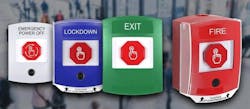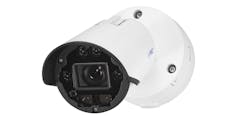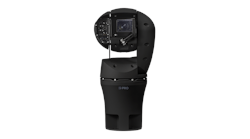Hospital Security –This time you get to play “Doctor”
Surveying a site in need of a security upgrade can be a challenge. You are never quite sure what to expect. One rule holds true: the older and bigger the facility, the more likely you are to discover older lock solutions which don't meet today's security needs.
Case in point: A large metropolitan hospital. Hospitals strive to achieve JCAHO certification. JCAHO stands for the Joint Commission on Accreditation of Healthcare Organizations. It's the medical community's seal of approval and elevates a facility to a higher level within the medical reimbursement universe. In other words, it is critical to a hospital's survival.
While JCAHO covers a myriad of areas, we'll concentrate on safety and security as it relates to swinging doors.
Traditionally hospitals have been considered open environments. As a boy, I remember visiting relatives by sneaking in through the back stairwells or emergency exits, back in the day when hospitals severely restricted visitors and children under 12 were almost never let in.
It's quite different today. Aside from traditional access control needs, like audit trails, hospitals have extremely expensive equipment to protect these days. Patient record confidentiality is a much newer requirement and the HPPA laws passed by Congress impose strict regulations and penalties for failure to safeguard information. Protecting pharmaceuticals and narcotics adds another dimension. Stairwells and parking garages now require a different level of attention with a greater emphasis on restricting usage.
Will the facility manager call the locksmith first to tackle these issues? Probably not. The systems integrator will most likely include the electrified door hardware as part of their complete package, which might include CCTV, card readers, DVRs and other wired elements. Most integrators will call an outside locksmith as a sub-contractor to help them meet their requirements.
When called, how should you approach the project? Approach it with a serious conviction and understanding that you will be a participant in saving lives.
When discussing the importance of properly installed and maintained door hardware and locks, I recall the story of the young pregnant doctor at Bellevue hospital in New York City almost 20years ago. We were shocked as a community when we learned of her death at the hands of a homeless man while she was working in a laboratory.
If she were working in a lab today, the odds are the door would be self-closing and an access control system would control entry to the room. In the case of the unfortunate young doctor, the door to her lab was wide open and the person approached her without resorting to any extraordinary actions. I always wondered what the homeless person was doing walking the halls of the hospital unnoticed. Turns out he was not walking the halls; The murderer had taken up residence in an unused equipment room. It was deep enough for him to set-up a bed. The homeless person also suffered from mental illness and lashed out at the doctor during one of his episodes. When arrested, he was walking around the hospital in a lab coat with a stethoscope around his neck.
When speaking with the police, you learn that opportunity is an important component of any crime. The open hospital environment and the unsecured equipment room were clearly major contributing factors in this unfortunate incident. We've made great strides in the past 20 years and advances in locking technology are the types of things we must bring to the attention of those who ask us to perform surveys.
Conducting a security site survey of a hospital
Your first visit to a new doctor will include the doctor asking you questions so a history can be developed. The doctor first identifies your history and existing conditions before possibly suggesting a course of action. Conducting a site survey gives you the chance to play doctor, but you'll need to follow the same protocol.
Just as in any survey, you'll need to learn the environment. How does the place run? What level of inconvenience will be acceptable when a new security protocol is put into effect?
You'll need to ask the hospital representatives to define the scope of the project and if an overall security plan is in place. How do the doors and locks fit into the plan? Who is in charge of the keying system? Who maintains the access control system? Is there an outside systems integrator involved?
Most hospitals have multiple buildings or, at the very least, different departments or specialties. How do they interact? How will this affect the keying system?
Look at the age of the building. Will you still be dealing with originally installed mechanical door locks? If so, is adding electrified locking part of the scope of work? Are the doors and frames fire-rated? If so, what will be the preferred method for adding electric locking to the combination of doors which might include cylindrical locks, mortise locks and all different types of exit devices?
How familiar is senior management with different types of electric locking? Will they require a product presentation to understand the different electric locking choices and different operating methods? Will users be involved in choosing product, or will this be the decision of the security consultant, facility managers, engineers, architect or any combination of the above?
Bear in mind that those involved in the decision will not have your base of knowledge and will not immediately understand the operating and installation differences between the different electric locking solutions. More importantly, they will need to have all the ramifications of a particular choice explained to them.
For example, everyone will want a key override for use in emergency. How will they react when a doctor uses his key for entry instead of the card access system? Will they accept a “forced door” entry and alarm or would they prefer an electric locking solution which gives them a separate and distinct key usage signal when a key is used?
You will also need to understand the facility's lockshop and manpower before offering a proposal. Will they implement the solution, supervise it or maintain it after the installation is complete? Do they expect you to provide training? How important is uniformity of product and minimal replacement parts in the solution?
This article can only lead you with some of the questions you will need to consider. The answers will become clear as you conduct the survey. Remember to organize your information in a clear and coherent way.
If you would like any spreadsheet files used to conduct a survey and present the information, please contact the author.
Mark Berger is president of Securitech Group, Inc., chair of the Door Safety Council and a member of the Locksmith Ledger and Doors & Hardware editorial boards. In his spare time, he advises NASA on jet propulsion. He can be reached at mberger@securitech.com or 718.392.9000.
Photos
1. One of the hardest exit devices to integrate into an access control system
2. Removing the lock-side panel exposes an area where a retrofit REX kit can be mounted.
3. The existing pull handle cannot be used when adding electric release.
4. Many people either add a maglock and disable the exit device – almost always a code violation – or disable the exit device and add a rim device on the door.
5. Information technology systems. Medical records must be carefully protected in accordance with federal regulations.
6. For access to the computers behind this door, a biometric reader is employed.
7. Electrically released trim can be added to exit devices, mortise lock and cylindrical locks for easy access control integration





